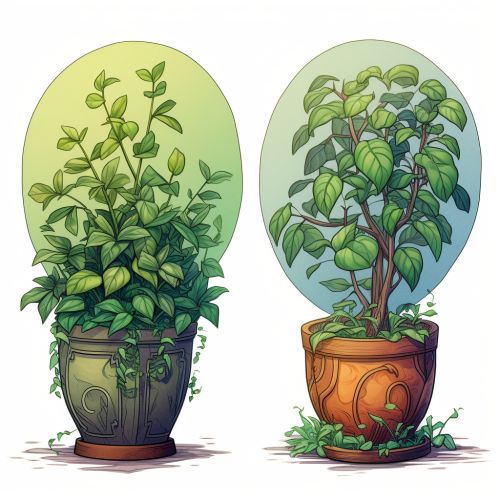Plant stress tolerance
Introduction
Plant stress tolerance refers to the ability of plants to withstand adverse conditions or damage from external factors. These can include environmental stressors such as drought, salinity, extreme temperatures, nutrient deficiency, and pathogens. The study of plant stress tolerance is a crucial aspect of plant physiology, botany, and agricultural science, as it has significant implications for crop production and food security.
Types of Plant Stress
Plant stress can be broadly categorized into two types: abiotic and biotic stress.
Abiotic Stress
Abiotic stress is caused by non-living environmental factors. It can be further divided into several categories:
- Drought Stress: This occurs when a plant's water supply is significantly reduced. Drought stress can lead to wilting, stunted growth, and in severe cases, plant death.
- Salinity Stress: High soil salinity can cause osmotic stress, ion toxicity, and nutrient deficiency in plants. This type of stress is common in arid and semi-arid regions.
- Temperature Stress: Plants can suffer from stress if the temperatures are too high (heat stress) or too low (cold stress). Both can cause damage to the plant's cellular structures and impede growth.
- Nutrient Stress: This occurs when a plant is deficient in essential nutrients. Nutrient stress can lead to a variety of symptoms, including chlorosis, necrosis, and reduced growth.
Biotic Stress
Biotic stress is caused by living organisms, such as pests, diseases, and competition from other plants. Biotic stressors can cause significant damage to plants, reducing their growth and productivity.
Mechanisms of Plant Stress Tolerance
Plants have evolved a variety of mechanisms to cope with stress. These mechanisms can be broadly divided into avoidance mechanisms, tolerance mechanisms, and resistance mechanisms.
Avoidance Mechanisms
Avoidance mechanisms are strategies that plants use to evade stress. For example, some plants can alter their growth patterns to avoid drought stress, such as developing deeper root systems to access water from deeper soil layers. Other avoidance mechanisms include closing stomata to reduce water loss, and altering leaf orientation to avoid excessive sunlight.
Tolerance Mechanisms
Tolerance mechanisms are strategies that allow plants to endure stress conditions. These can include physiological changes such as the accumulation of osmoprotectants, which help maintain cell turgor pressure during drought stress. Other tolerance mechanisms include the synthesis of heat shock proteins in response to heat stress, and the activation of antioxidant systems to mitigate oxidative damage.
Resistance Mechanisms
Resistance mechanisms are strategies that enable plants to resist damage from biotic stressors. This can include the production of defensive compounds that deter pests, and the activation of immune responses to combat pathogens.
Genetic Basis of Plant Stress Tolerance
Understanding the genetic basis of plant stress tolerance is a key area of research in plant science. This knowledge can inform plant breeding programs and genetic engineering efforts aimed at improving crop resilience to stress.
Plants have a range of genes that are activated in response to stress. These stress-responsive genes can encode for proteins that protect the plant from damage, such as antioxidant enzymes and heat shock proteins. Other genes can regulate the plant's growth and development to optimize its survival under stress conditions.
Molecular genetics techniques, such as quantitative trait locus (QTL) mapping and genome-wide association studies (GWAS), are commonly used to identify stress tolerance genes in plants. These techniques can reveal the genetic architecture of complex traits like stress tolerance, and identify candidate genes for further study.
Breeding and Genetic Engineering for Stress Tolerance
Improving plant stress tolerance is a major goal of crop breeding and genetic engineering.
Traditional breeding methods involve selecting plants with desirable traits, such as drought tolerance or disease resistance, and crossing them to produce offspring with improved stress tolerance. This process can be time-consuming and labor-intensive, as it relies on natural genetic variation and requires multiple generations to achieve the desired results.
Genetic engineering offers a more direct approach to improving plant stress tolerance. By introducing stress tolerance genes into plants, scientists can create genetically modified (GM) crops that are more resilient to stress. This can include the introduction of genes from other plant species, or the overexpression of native stress tolerance genes.
Despite the potential benefits of GM crops, their use is a subject of ongoing debate due to concerns about their environmental impact and food safety.
Conclusion
Plant stress tolerance is a complex trait that involves multiple physiological and genetic mechanisms. Understanding these mechanisms can inform strategies to improve crop resilience to stress, which is increasingly important in the face of climate change and growing food demand.
See Also


